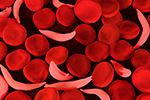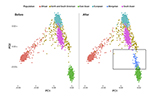

 In the first study of its kind, NHGRI researchers explored patients', parents' and physicians' perspectives on the use of CRISPR-Cas9 gene-editing to reverse sickle cell disease. Study participants expressed overall optimism about participating in human genome editing clinical trials, but were concerned about treatment risks and transparency of the research enterprise, according to the findings published December 24 in Genetics in Medicine..
In the first study of its kind, NHGRI researchers explored patients', parents' and physicians' perspectives on the use of CRISPR-Cas9 gene-editing to reverse sickle cell disease. Study participants expressed overall optimism about participating in human genome editing clinical trials, but were concerned about treatment risks and transparency of the research enterprise, according to the findings published December 24 in Genetics in Medicine..
 NHGRI researchers have discovered a hormone in a mouse study that can be used immediately to can help doctors predict how severely patients with the rare disease methylmalonic acidemia are affected and when to refer them for liver transplants. The findings, published December 6 in JCI Insight, also might shed light on more common disorders such as fatty liver disease, obesity and diabetes.
NHGRI researchers have discovered a hormone in a mouse study that can be used immediately to can help doctors predict how severely patients with the rare disease methylmalonic acidemia are affected and when to refer them for liver transplants. The findings, published December 6 in JCI Insight, also might shed light on more common disorders such as fatty liver disease, obesity and diabetes.
 Andy Baxevanis, Ph.D., a senior scientist leading the Computational Genomics Unit at the National Human Genome Research Institute (NHGRI), has been named a Fellow of the American Association for the Advancement of Science (AAAS). Dr. Baxevanis was recognized for his distinguished contributions to the field of comparative genomics, particularly for using computational approaches to study the molecular innovations driving diversity in early animal evolution.
Andy Baxevanis, Ph.D., a senior scientist leading the Computational Genomics Unit at the National Human Genome Research Institute (NHGRI), has been named a Fellow of the American Association for the Advancement of Science (AAAS). Dr. Baxevanis was recognized for his distinguished contributions to the field of comparative genomics, particularly for using computational approaches to study the molecular innovations driving diversity in early animal evolution.
 North Asians, including Mongolians and other Siberian ethnic groups, may be more closely related to Eastern and Northern Europeans - including the people of Finland -- than previously thought, according to a new genomics study in Nature Genetics. The international team of researchers, including those from the National Human Genome Research Institute (NHGRI), made the connection by comparing the whole-genome sequences of 175 ethnic Mongolians to existing genetic variation data.
North Asians, including Mongolians and other Siberian ethnic groups, may be more closely related to Eastern and Northern Europeans - including the people of Finland -- than previously thought, according to a new genomics study in Nature Genetics. The international team of researchers, including those from the National Human Genome Research Institute (NHGRI), made the connection by comparing the whole-genome sequences of 175 ethnic Mongolians to existing genetic variation data.